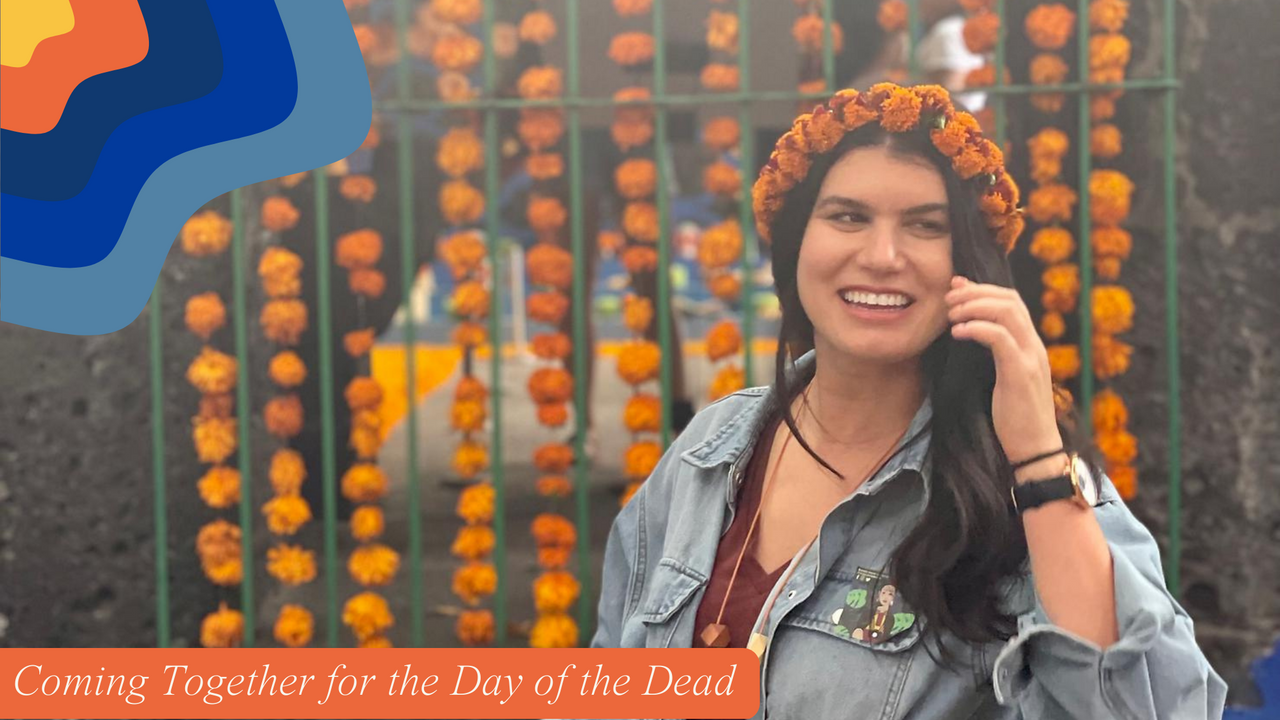Coming Together for the Day of the Dead
Nov 03, 2022
No one was crying at the cemetery.

No one was crying at the cemetery.
On November 1st, there were hundreds of people at the Panteón General, a historic cemetery in Oaxaca City, Mexico. Generations of families, young and old, visited the graves of their loved ones.
But there were no tears.
They were strumming guitars and sipping Tecate. They brought brooms to sweep off the year’s debris from tombstones, and flowers, food, and papel picado (paper streamers) to decorate them in a beautiful combination of textures and colors. And there was what I can only describe as a death-themed state fair outside the gates of the Panteón.
My visit to Mexico for the Día de los Muertos (Day of the Dead) challenged my preconceptions about our relationship with loved ones who are no longer with us: in a holiday all about death, I saw not one moment of sadness.
When I started Grieve Leave, I knew I wanted to experience Día de los Muertos as a part of my year of learning. I’d spent much of my career working in education and policies that support Hispanic communities across the US, and I’d studied Spanish and Latin American history. So, I knew that Día de los Muertos had thousands of years of significance in indigenous Mexican cultures, and that the holiday has evolved into something much flashier today. But I wanted to see how grieving and the Day of the Dead intersect. So, I went to Mexico City and Oaxaca City to check it out up-close.
From the moment I landed in Mexico, it became clear that Día de los Muertos is, first and foremost, not just one día: it’s an entire season that focuses on togetherness with the dead. How do you come together with people who are gone, you might wonder? I saw so many moments, big and small, that sat the living and the dead side-by-side, literally and figuratively. And nothing was sad about it.
The big, public parts of the holiday tend to get most of the attention: Mexico City’s parade gathered more than one million spectators this year, for example. (Funnily enough: the city’s parade is only a few years-old—after a James Bond movie in 2015 featured a fictionalized Day of the Dead parade there, Mexico City decided to really do it.) Likewise, many of Oaxaca City’s streets and plazas make way for thousands of revelers, local and tourist. In both cities, skeletons were everywhere: they were painted on people’s faces and murals on the sides of buildings, and there were huge paper mâché skulls adorning the streets. I ate pan de muerto or “death bread” (fun fact: death tastes sweet and airy, who knew?) and I donned cempasúchil (marigold) flower crowns. The smell of the marigolds draped all over the city and on spectators’ heads is intoxicating and meant to lead souls back from their burial places. All of these traditions are intended to center death right alongside life, in celebration.
But it’s the smaller moments of togetherness that stood out to me most: ofrendas (altars) dedicated to the deceased were in every corner, featuring photos of dead loved ones, flowers, candles, pan de muerto, and the dead person’s favorite foods. Practically every building— homes, restaurants, drug stores, airports, banks, hotels— had an ofrenda at its entrance dedicated to members of that community who had passed. Some were ornate and expansive, while others were small and simple. The whole idea of an ofrenda is to welcome back the dead, and to feed their spirit when they get there. It’s about loving your person in death just as you loved them in life, and to feel them with you, still…
Back in the cemetery in Oaxaca City, many of the individual graves in the Panteón General have marble benches built in for visitors to sit down. The entire site is physically designed for spending time together with the departed. Some graves have actual enclosures, almost like tiny houses, for the purpose of gathering together right there in the cemetery, to be with your loved one. I’ve written this year on my discomfort with cemeteries, but this experience helped me see another side to them: a cemetery can be a place where families come together, with the living gathering comfortably alongside the dead.
In all of these Día de los Muertos moments, big and small, I was reminded of my conversation with my rabbi on Jewish traditions around grief and grieving—my own heritage. Rabbi Soffer told me “…the soul doesn't go away…bodies die, souls are droplets of God.” And he went on to remind me that, according to Jewish tradition, even though my parents are physically gone, their souls are now bound up in me.
That same idea, ultimately, is what I was so lucky to see during my trip for Día de los Muertos. This holiday helps us remember that we are connected to the souls of the people we loved. They are still present, here, with us, in this land of the living, even though their bodies aren’t. We can still come together.
And we don’t have to cry.
Grieve on.
---If you like learning about grieving alongside me, scroll down to the bottom of this page and sign up for my mailing list---







Join the Grieve Leave movement
Share your info to join our Grieve Leave community. You don’t want to miss anything!


